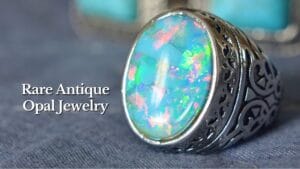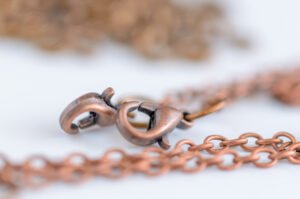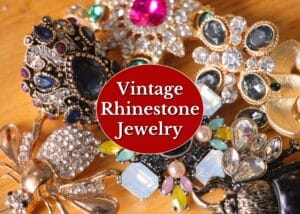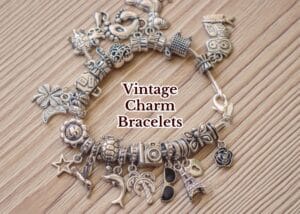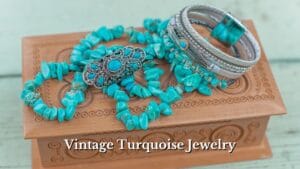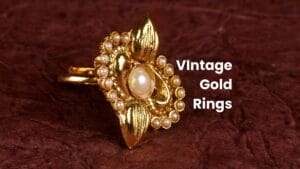Vintage costume jewelry is no joke, especially if it comes with rare natural gemstones! It may seem to be just a piece of junk with random stones, but it could actually be worth way more than your modern gold or platinum pieces, if that stone is opal!
Antique opal jewelry – specifically, pieces from the Art Nouveau, Edwardian, and Art Deco periods – is extremely precious today! Losing a small earring with an opal stone could mean a loss of thousands, and I’m sure you won’t want that!
So, let me walk you through what makes some antique opal jewelry items worthless and other pieces worth a big fortune, and how to spot real opal!
What Is Opal & Why Is It Special?
Opal isn’t like other gemstones. It’s a mixture of silica and water that creates those magical flashes of color called “play-of-color” or “nature’s own disco ball,” as I like to call it. Each opal has millions of tiny silica spheres stacked like microscopic ping-pong balls.
When light hits them, it splits into all the colors of the rainbow. The size of these spheres determines what colors you see. Smaller spheres give you cool tones like blues, greens, and violets, while larger ones create those fiery reds and oranges that collectors look for!
11 Rare Opal Jewelry Pieces Worth Collecting
Now let’s take a look at some rare vintage opal jewelry pieces that are worth a lot. In fact, I’ve seen every one of these types sell for hundreds to thousands at auction.
1. Black Opal Diamond Cocktail Ring
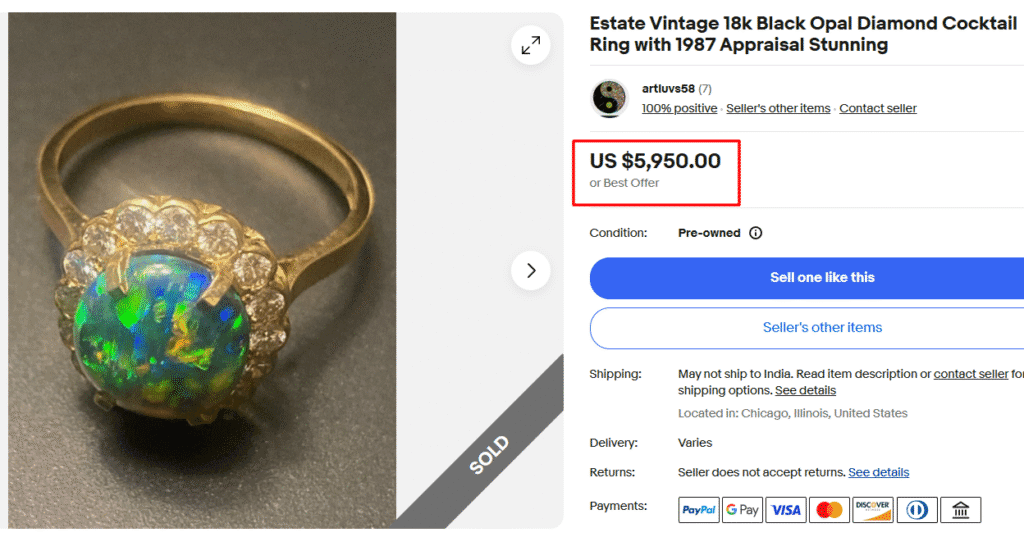
This exotic cocktail ring features a premium black opal from Lightning Ridge, Australia’s most prestigious opal mining location. The vibrant play-of-color displays electric greens and blues characteristic of top-grade black opals.
What makes this piece sell for over $5,900 is its expensive frame of over 15 diamonds set in an 18k gold setting – total luxury! With all the precious elements, this super rare cocktail ring is a true example of 1980s high-end jewelry when bold cocktail rings dominated fashion!
2. Vintage Gold, Diamond & Opal Ring
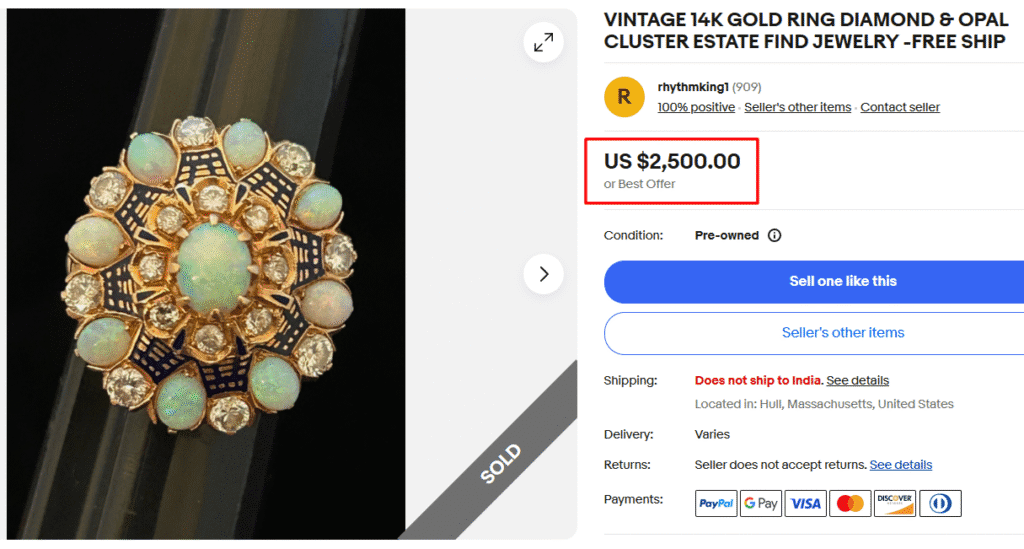
This is an extraordinary vintage gold cocktail ring with not just one but a magnificent cluster of opals of varying sizes! The stones are arranged in a floral pattern with diamond accents throughout the 14k gold setting – speak of a more exotic arrangement!
The design is typical of mid-century luxury, but what makes this ring rare is that each opal displays unique color patterns ranging from soft pastels to vibrant fire, creating a kaleidoscope effect! The high-quality elements and excellent condition make this piece worth the price tag of $2,500!
3. Opal Gold Cameo Brooch Pin Pendant

This vintage cameo offers a glimpse of the rare art of opal carving! It features a classical female portrait carved from iridescent white opal against a black background. Set in the 14k yellow gold setting, the detailed cameo and elegant decorative border give pure Victorian-era vibes!
Opal cameos are exceptionally rare because the stone’s fragility makes carving extremely difficult. And the iridescent play-of-color visible in the portrait is just another irresistible feature adding to its value!
4. Australian Opal & Natural Diamond Platinum Pendant

This vibrant vintage pendant secures a museum-grade (11.96-carat) Australian opal with its brilliant play-of-color in greens, oranges, and blues. What makes this piece reach a steep price of $3,500 is its lavish setting of 1.58 carats of natural diamonds and platinum!
This pendant is also desirable because Australian opals of this size and quality are increasingly rare. Besides, its unique shape and fine diamond work are just extraordinary!
5. Calvin Begay Navajo Gold Opal, Coral, Lapis Inlay Horse Pendant
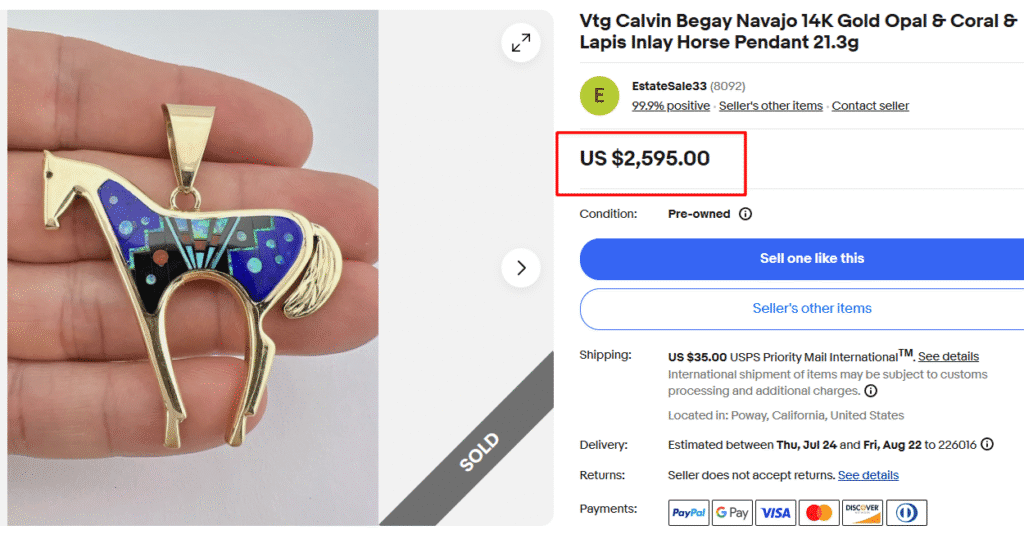
This is a museum-quality pendant by Navajo artist Calvin Begay, featuring unique Native American inlay artistry. It’s a 14k gold horse-shaped pendant with intricate inlays of white opal, coral, and lapis lazuli in geometric patterns set in traditional Navajo designs.
This piece is historical as it’s a true example of Begay’s signature style of blending cultural heritage with contemporary designs. The high price tag of this pendant is thanks to its mint condition, high-karat gold setting, and use of more than one natural stone!
6. Alaska Gold Opal Cabin & Scenic Northern Lights Pendant
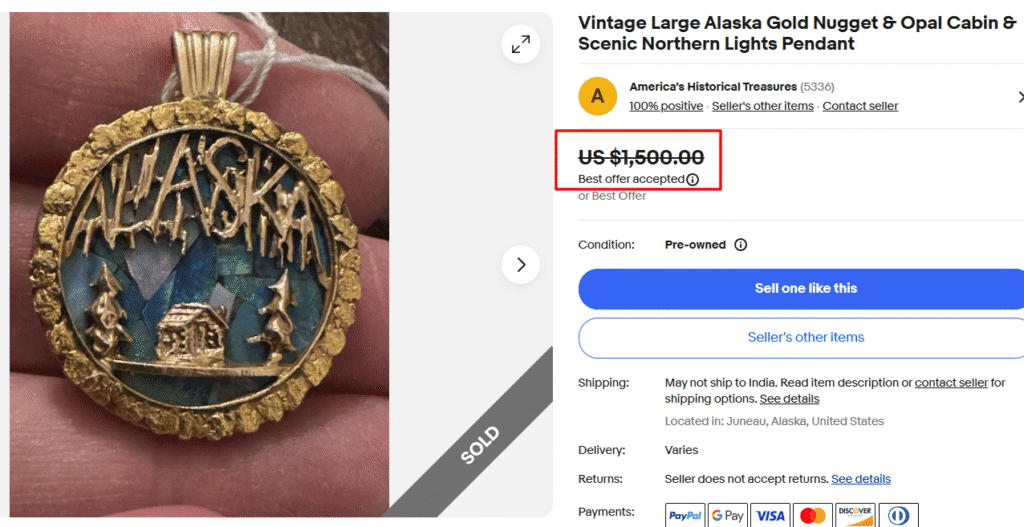
This rare pendant combines genuine Alaskan gold nuggets with opal to create a miniature wilderness scene! You will see a log cabin and stylized northern lights with the “ALASKA” lettering on the top of the stone.
This is a unique piece of regional jewelry art blended with the romance of the Last Frontier. The combination of raw gold nuggets with polished opal creates a stunning, one-of-a-kind textural contrast with the scenic motif.
Such themed jewelry from Alaska has been quite popular with collectors due to its regional ties and historical significance!
7. Mexican Fire Opal Gold Pendant
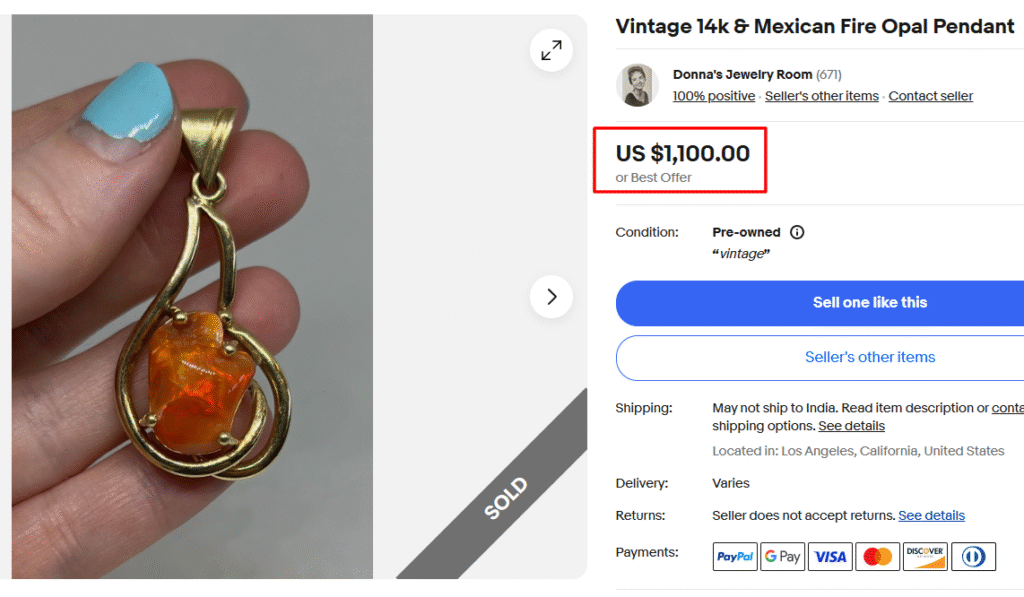
This is an exclusive pendant every collector would want to have! It’s a 14K gold pendant with the intense orange-red Mexican fire opals from Querétaro. The stone displays the classic “cherry” color that made Mexican fire opals famous among collectors and jewelers.
What makes Mexican fire opals more unique is their transparency and intense single-color saturation rather than the typical play-of-color. Moreover, the unique and elegant twisted bail design puts this piece in the mid-century era; it has all the right signs worth the price it sold for!
8. Large Ball of Blue Opal Sterling Necklace Pendant
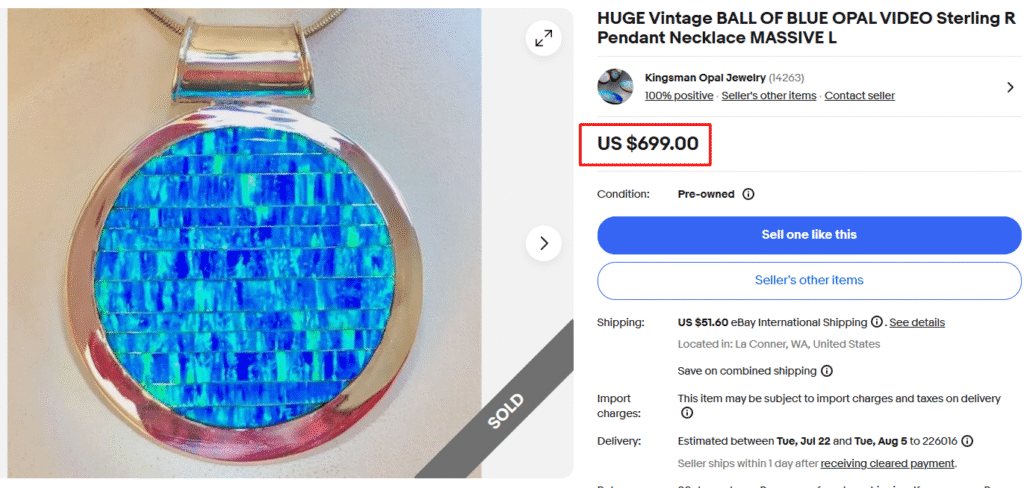
Now this is something really rare! It’s a striking pendant featuring an unusually large spherical blue opal displaying mesmerizing geometric patterns that create an almost mosaic-like effect.
However, the intense blue coloration with systematic linear patterns suggests this may be a high-quality synthetic opal or treated natural stone from the mid-20th century. Besides, set in sterling silver with a substantial chain, this piece sold for almost $700, which is too less for a natural opal this big!
But it’s worth noting that such distinctive synthetic opal pieces from this period are also increasingly collectible as examples of innovative jewelry!
9. David Freeland Ladies Opal Bracelet
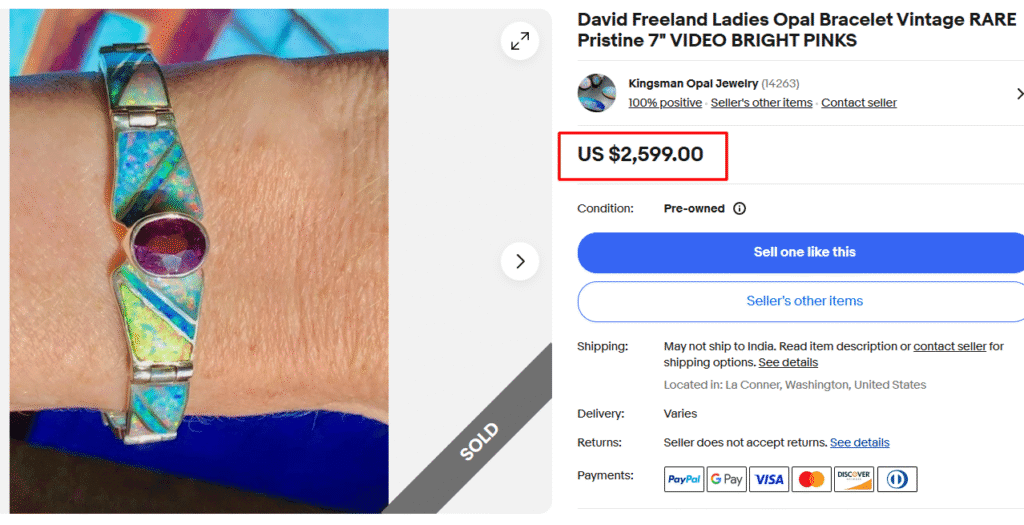
This is an exceptional opal bracelet designed by renowned designer David Freeland Jr.! It greatly showcases his signature micro-inlay technique with brilliant pink opals creating a stunning geometric pattern.
Freeland is internationally popular for his innovative lapidary work. As you can see, each opal segment displays intense color saturation in bright pinks, demonstrating Freeland’s skill in selecting and cutting matched stones.
The pristine condition and size make this a museum-quality opal piece worth the steep price tag of almost $2,600! It also shows that Freeland’s pieces are highly sought by collectors!
10. Art Deco 14K Andamooka Opal Ring

This large, rare Art Deco ring features a substantial Andamooka opal with its brilliant green and blue fire set in 14k gold with geometric detailing. Andamooka opals from South Australia are prized for their unique matrix patterns and intense color play.
Apart from the gold setting and large stone size, this ring is also rare thanks to the unusual shape of the stone – what would you call that, right? Andamooka opals have serious popularity, and while this piece sold for $475, pieces with gemstone settings can be worth $500-$1,500+!
11. Boulder Opal, Garnets & Diamonds Gold Butterfly Pin
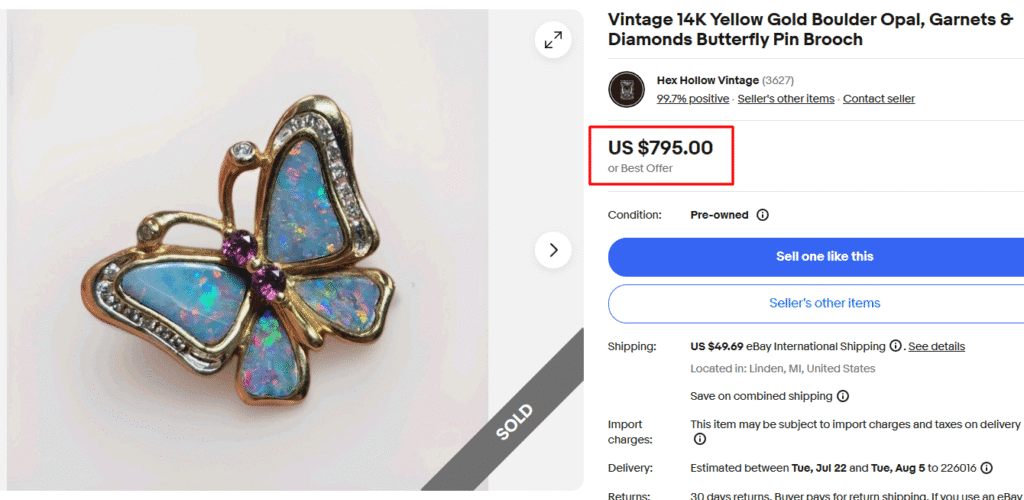
This is a rare butterfly brooch from the mid-20th century! It features dazzling wings made from Australian boulder opal, with its amazing flashes of blue and green, which opals are famous for.
Apart from that, what makes this brooch special is the mix of stones – you’ve got pink garnets forming the body and tiny diamonds adding extra sparkle. Boulder opals are pretty rare since they only come from Queensland, Australia, making this piece worth the high value!
How to Know Your Antique Opal Jewelry is Real?
The vintage jewelry market has such a wide range of gemstones that look just like opal! So, spotting a real opal can be tricky, unless you know what to look for!
Here’s a detailed explanation of all the key features of real opal jewelry:
Types of Opal
Not all opals are equal. Knowing the different opal types will help you understand what you’ve got and what it’s worth.
- Black Opal: These are the most precious of all opals. Black opals have a dark body color that makes their fire absolutely pop. Most come from Lightning Ridge in Australia, and the best ones can sell for $10,000 per carat or more.
- White Opal: White opals have a light, milky background with a soft color play. These were popular in Victorian jewelry, and although they’re more common, they’re still collectible for their beauty.
- Mexican Fire Opal: These come mainly from Mexico and range from yellow to deep red. Fire opals don’t always show play-of-color, but when they do, they’re spectacular, like a sunset.
- Crystal Opal: These are transparent or semi-transparent, so you can see through parts of the stone. When they have good color play, crystal opals can be incredibly valuable! Some are dark enough to be called “black crystal opals,” and are super rare!
- Boulder Opal: Boulder opals form in ironstone rock, and cutters leave some of the host rock attached. The results are natural patterns that look like abstract art. Each boulder piece is unique in itself.
- Matrix Opal: In matrix opals, the precious opal fills tiny spaces in the host rock, creating a natural mosaic. Some are treated to enhance the contrast, but the untreated ones are more valuable.
Natural Vs. Synthetic Opals Vs. Fakes
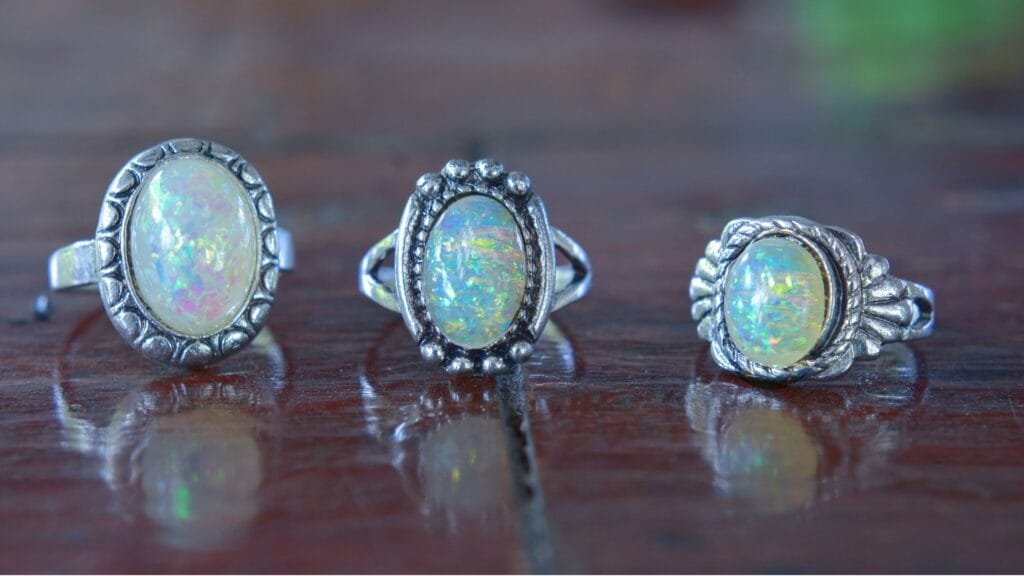
Real opals have a unique personality. Their patterns are random and organic – no two stones look exactly alike. When you tilt a natural opal, the colors dance and shift in unpredictable ways.
On the other hand, synthetic opals are laboratory-made with almost “too perfect” patterns and sometimes a “lizard skin” or “chicken wire” effect under magnification. They’re still real opal chemically, but they’re worth a fraction of natural stones.
The following table will help you differentiate between a natural, synthetic, and fake opal based on some key features.
| Features | Natural Opal | Synthetic Opal | Fake Opal |
| Color Patterns | Natural flow across the stone | Too perfect or uniform | Painted-on appearance |
| Pattern Style | Irregular and unique | Chicken wire, or honeycomb pattern | No true play |
| Weight | Solid and substantial | Slightly lighter than natural | Very light (plastic) or heavy (glass) |
| Inclusions | Natural imperfections visible | Manufactured uniformity | Air bubbles visible |
| UV Fluorescence | Often glows under UV light | No fluorescence | No fluorescence |
| Surface Quality | Durable, clearn & shiny finish | Smooth, manufactured feel | Coating may scratch off |
| Color Movement | Colors dance when tilted | Less dynamic color play | Zero movement |
Apart from this, there are “simulants,” which are just materials that look like opal but aren’t the real thing. You’ll run into glass (often called “Slocum Stone”), plastic, and assembled stones that try to mimic an opal’s appearance.
Then there are “Doublets” and “Triplets!” These are composite stones made from layers. A doublet takes a thin slice of genuine opal and glues it to a dark backing, like onyx or plastic, to make the colors pop more.
A triplet goes one step further by adding a clear domed layer on top – usually quartz or glass – for protection and to magnify the opal’s fire. When you’re looking at a loose stone or can see the side of a set one, those distinct layers are usually pretty obvious!
Easy Scientific Tests
Apart from these signs, there are a few scientific tests that can nail down whether you’ve got real opal or not:
- UV Light Test: The unique fluorescence created when the stone is exposed to UV light is a key sign. Natural opals often show a distinctive glow, varying based on where they came from. Synthetic opals might fluoresce a dull green or show no reaction at all.
- Refractive Index (RI): If you can, use a gemological tool called a refractometer to measure how light bends when it passes through the opal stone. Natural opal will show an RI of 1.44-1.46. So, this can be a great clue.
- Specific Gravity (SG): This measures the stone’s density. Natural opal generally falls between 2.10 and 2.20 on the SG scale.
What Decides the Value of Opal Jewelry? (5 Key Factors)
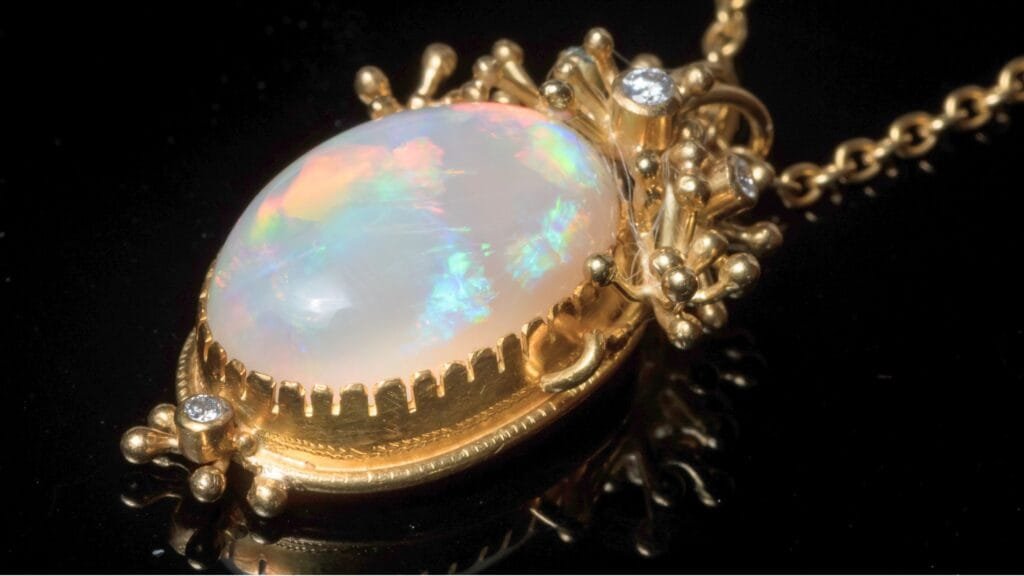
Understanding what makes one opal worth $500 and another worth $50,000 is crucial when investing in it or selling it. And trust me, it’s not just about size, though that matters too.
Opal Quality Factors
- Opal Type: The type of opal matters a lot. Black opals are generally the most valuable, followed by boulder opals, crystal opals, and then white opals.
- Body Tone: This is crucial for black opals. The darker the body tone (N1-N4 on the body tone scale), the more desirable it is.
- Color: The opal’s color can make or break value. Red in the play-of-color is highly prized, and having a full spectrum of colors bumps up the worth considerably.
- Clarity: It largely affects value, though it’s not always straightforward. Inclusions and blemishes usually hurt the price, but some patterns in boulder opals are considered desirable.
- Brilliance: How bright that play-of-color is – is a key factor that collectors pay attention to.
Condition & Other Features
Not every vintage opal piece is a goldmine – the value depends on the overall condition and appearance of the stone. Here are some key signs to pay attention to:
- Crazing: Those spider-web cracks that happen when opals dry out. Once crazed, an opal is basically worthless.
- Heavy damage: Chips, cracks, or missing pieces (missing opal stones from the setting) can’t be easily repaired.
- Obvious repairs: Glued pieces or replaced stones hurt value significantly.
Also, the condition of a jewelry piece’s setting or frame impacts the value, too. Opal pieces with worn-out precious metal settings may be worth slightly less than those with well-preserved examples.
Opal Size & Shape (Cutting)
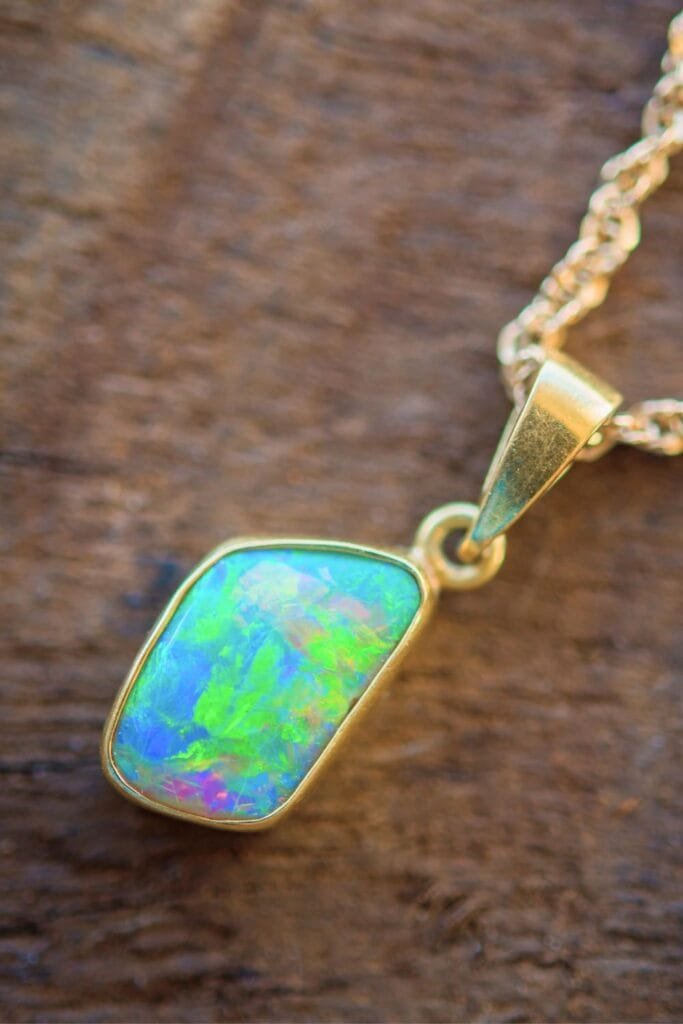
Naturally, bigger opals are rarer and generally worth more, but quality is way more important! A smaller opal with exceptional fire can easily be worth more than a larger, duller stone.
Also, how the opal is cut plays a vital role in its value. It should be cut in a way that it showcases its play-of-color to maximum effect to be valuable.
Unique, well-executed carvings can add rarity and value to a piece. For instance, Cabochons (those smooth, domed tops) are the most common cut for opals.
Base Material & Other Gemstones
The metal used in the setting of an opal jewelry piece and the presence of other gemstones are other crucial factors influencing its value. Here’s how:
- Precious Metals: Opal set in high-karat gold (14k, 18k) and platinum settings are the holy grails! These pieces in good condition can sell for $2,000 to $10,000+. Sterling pieces can also fetch $500-$2,000+.
- Gemstones: Opal jewelry pieces featuring other high-quality gemstones like old-mine-cut diamonds, natural pearls, and coral can be double or triple the price of a plain opal piece.
Markings & Signs
Hallmarks and maker’s marks are like fingerprints for vintage jewelry. These tiny stamps reveal metal content, the assay office that tested it, manufacturing year, and sometimes even the designer or workshop that created it.
For example, Sterling opal pieces will have “925” and “Sterling” marks apart from brand marks, like “Tiffany & Co.” Opal jewelry set in a gold setting features the “14K” or “18K” hallmarks.
Researching these marks can help you trace your opal piece’s history. And these marks seriously impact its value.
Note: This article is intended for informational, educational, and entertainment purposes only. Some images are illustrative and may not represent actual brands, products, or related entities. All trademarks, product names, brand logos, packaging, and other intellectual property referenced remain the exclusive property of their respective owners. Any brand mentions or references are provided solely for descriptive and educational context and do not imply any formal or commercial association.

